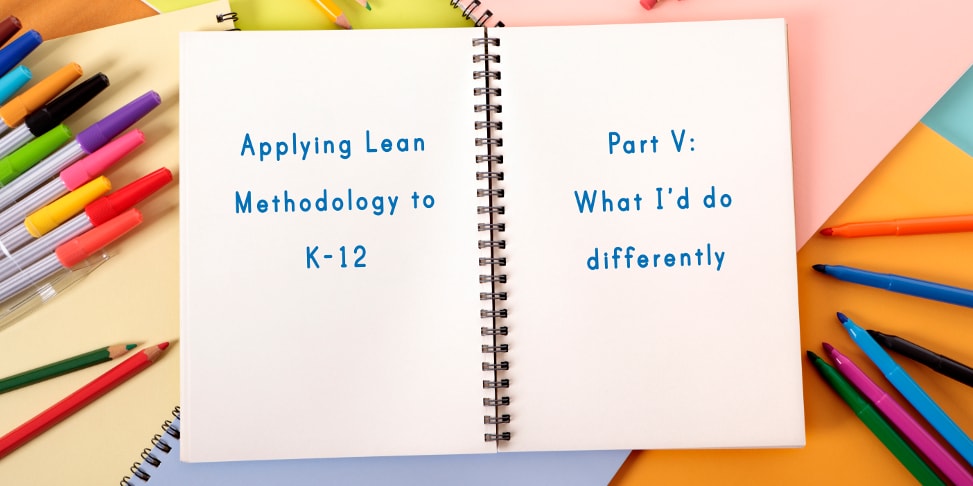
This is my final segment for this particular series on applying lean startup principles to the process for improving learning in the K12 environment. My previous entries recount the journey of developing an MVP for education, determining what to build, measuring for impact, and learning how to move forward. I’ll conclude this series by sharing what I’d do differently knowing what I know now.
If I could go back into time, I would have admitted up front that education is an experiment:
– an act or operation for the purpose of discovering something
unknown or of testing a principle, supposition, etc.
At first it seemed blasphemous to state that we were experimenting on students. But if we are honest, isn’t every classroom a learning lab every day? When we select a tool or an instructional approach to try, do we really know that it will work? Considering individual needs, do we know what will work for each student? We may have an educated guess. Even if a selected strategy meets the criteria of the What Works Clearinghouse, how do we know that it will work for this student in this setting under these circumstances? At best, it’s a research-based educated guess.
By referring to lean startup methodology, we are applying a scientific approach for finding what really works for our students. This is not about blindly applying business principles to education. In the same way that lean manufacturing informed other lean movements, lean startup principles are not a direct translation. I’m writing about a process for lean instruction. This cross-pollinated thinking helped me realize that if most instructional decisions are experiments, let’s be more scientific in our approach. This paradigm shift allowed us to test and learn what instructional strategies were actually helping students.
In hindsight, I would have been more open about this realization. While I had made the shift in my mind, it took a while for the teachers to realize that we weren’t operating under the mentality: “This is the plan, and we need to stick to it come hell or high water.” Or more so, it took time for the teachers to realize that (as a school leader) I wasn’t operating with that mentality. They seemed relieved by the opportunity to discuss what was really working (and what wasn’t) and make adjustments from validated learning.
Reflecting on last year’s process, the teachers met this summer and decided to adjust the assessment process that we used in our build-measure-learn loop. They’ve opted to shorten the length of the student quizzes so as not to consume too much instructional time. They are also building in quick pre-assessment measures to gauge a better sense of where students are prior to the use of an instructional approach.
While the teachers are experienced with incorporating pre-assessment, the decision to have a common pre- measure could lead to several benefits. 1) Teachers have a shared barometer for understanding what students already know. They may find that while the student learning needs are diverse, the individual challenges are not unique to each classroom. For example, on any given day, many classrooms within a school have a student who is missing a major prerequisite skill, a student who learns better with manipulatives, a student who has already mastered the concept about to be presented, a student with ADHD who needs periodic movement breaks, a student reading below grade level, etc. Why plan instruction to meet these diverse needs in isolation? Teachers can enter the collaborative planning process with a better sense of individual needs and share ideas for classroom implementation. Those ideas can then be captured within the lessoncast space for differentiation and chronicled for the school community. 2) Having targeted pre-assessment data would have shortened our cycle for learning what instructional approaches were actually leading to student growth. We still would have had to examine student data over time, but perhaps less time might have passed us by before we were able to definitively declare the need to pivot.
We learned a lot together, and it’s with mixed emotions that I transition from my role as assistant principal to fulltime leadership of LessonCast Learning LLC. Saying goodbye left a lump in my throat, especially after the State assessment results were published. We had made adequate yearly progress (AYP) for the first time in years. No longer were we deemed as failing. I do not consider high-stakes testing to be the ideal or ultimate measure of student learning, but I couldn’t help but feel the chip slide off my shoulder.
As the journey continues, I’m now working globally to share lean instruction methods. With the LessonCast tools and process, our partner schools are able to capture their validated learning in a format that is repeatable, shareable, and scalable. A new chapter and a new school year begin. What are we willing to learn and do differently today?

